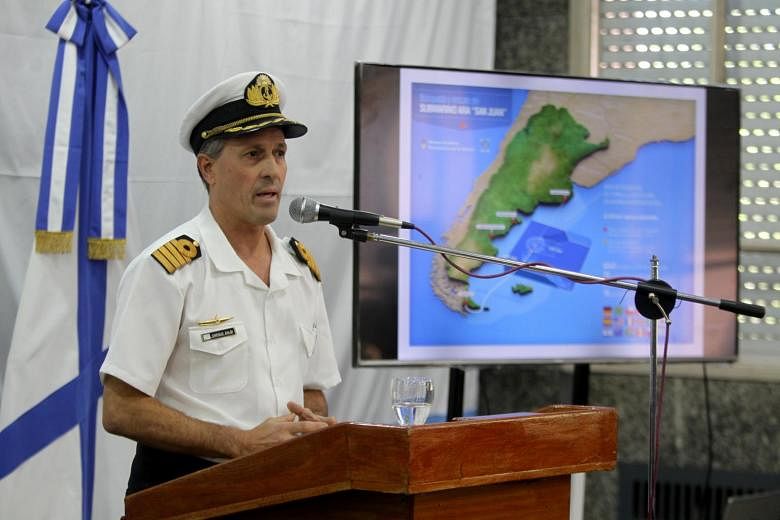BUENOS AIRES (NYTIMES) - The Argentine navy on Thursday (Nov 30) signalled that it had given up hope of finding the 44 crew members aboard a submarine that appeared to have experienced a calamitous event in mid-November.
The announcement was almost certainly an acknowledgment of the largest loss of life aboard a submarine in nearly two decades.
Captain Enrique Balbi, a navy spokesman, said the operation to find the submarine, the San Juan, had been downgraded from a rescue mission to a search for the remains of the vessel.
Some relatives of crew members reacted angrily to the decision and complained that they first learned about it on the news.
"This measure destroyed the last bit of hope I had," Mr Luis Tagliapietra, the father of one of the missing sailors, Alejandro Damián Tagliapietra, told the cable news channel Todo Noticias. "I want to know what happened for real, because I don't believe the official hypothesis at all. They lie to us."
Capt Balbi said the navy would not "give categorical confirmation" that the crew members were dead. But he noted that the rescue effort had continued far beyond the time the submariners were likely to have survived, even if the vessel had not experienced a catastrophic event.
The disappearance of the San Juan, which was last heard from on Nov 15, transfixed Argentines during the early days of the search. Military personnel from 18 nations rushed to a large stretch of the ocean off the coast of Patagonia to mount one of the largest maritime search missions in modern times.
Roughly 4,000 military personnel, 28 ships and nine aircraft participated in the search.
Relatives of the crew members largely gave up hope last week after officials disclosed that sensors had detected an unusual event that appeared to be an explosion in the area where the vessel had been sailing hours after the crew was last in contact.
During that call, the submarine's captain reported that a leak had damaged part of the vessel's battery system.
Some relatives said even then they had held out hope for a miracle.
"Some days I got up and felt hopeless, but then I would run into somebody, or receive a message that referred to the possibility of finding them alive, and suddenly I was filled with hope again," said Mr Carlos Miguel Mendoza, 46, the brother of one of the missing sailors, Fernando Mendoza, 38. "But now it seems that as far as they are concerned, all is said and done, and they are, sadly, no longer alive."
Fatal submarine incidents are extraordinarily rare in peacetime. The last major accident aboard a submarine happened in 2000, when a Russian vessel, the Kursk, sank during a training exercise with 118 onboard.
Argentine officials have said the San Juan was seaworthy when it set out on a routine training mission on Nov 8 during which the sailors also sought to interdict illegal fishing boats.
The German-made vessel had been in commission since the mid-1980s and had recently undergone a complete overhaul.
Relatives said they did not understand why navy officials disclosed that the submarine had experienced battery problems only several days into the search. Some are planning to take legal action to try to learn whether the navy knows more than it has disclosed to date.
"The only thing I want is for my son to turn up," said Ms Hilda Raquel Colombani, 65, Mendoza's mother. "If he's dead, I want his body so that we can carry out a proper Christian burial and to make sure he is not left in the bottom of the ocean forever."

